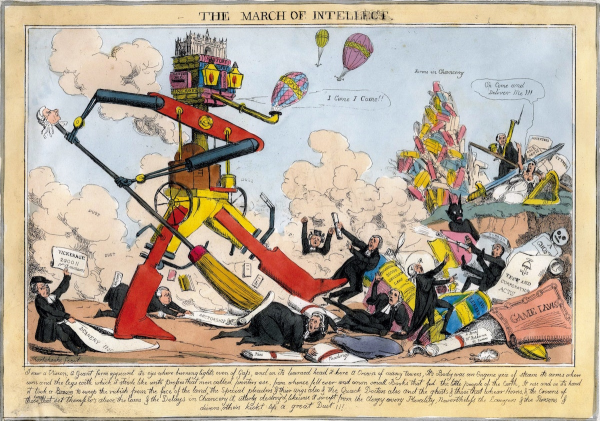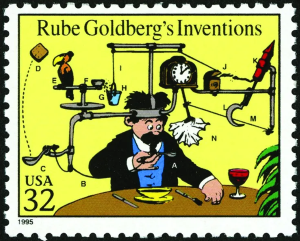A Look at the Future from the 200 Years Ago
What did the future look like in 1820s Britain? Poking fun at liberal ambitions for education reform, the rapid pace of industrialization, and a fashionable interest in applied knowledge, William Heath’s March of Intellect series offered a satirical vision of the wonders and potential cost of progress.

We find a more apocalyptic vision of the future in Robert Seymour’s 1820s The March of the Intellect, where a jolly automaton stomps across society. Its head is a literal stack of knowledge — tomes of history, philosophy, and mechanic manuals power two gas-lantern eyes. It wears secular London University as a crown. The machine smokes while crusading, blowing hot-air-balloon follies from a pipe bowl, carried on the breath of its menacing exhalation: “I Come I Come!!”. Wielding a straw broom, capped with the head of reformer Henry Brougham, it sweeps away all potential encumbrances.
The Public Domain Review looks at The March of Intellect cartoons from 1828/29 by Heath, Seymour, and others.
The Future Was Then
Goldberg was born on July 4, 1883, right on the cusp of the country’s first great technology boom, in which America’s original tech bros—Thomas Edison, Alexander Graham Bell, Samuel Morse and the Wright Brothers chief among them—started to transform everyday life. He grew up in San Francisco, which at the time was home to the second-largest population of Jews in America. He taught himself to draw by tracing the cartoons in humorist Edgar Wilson “Bill” Nye’s History of the United States, then took lessons from a sign painter to learn technique.

… The main character in Goldberg’s The Inventions of Professor Lucifer Gorgonzola Butts bore a strong resemblance to a figure from the cartoonist’s past: Professor Slate from UC Berkeley. Goldberg formatted each comic in the series like a patent application for a convoluted Barodik-like contrivance, complete with step-by-step instructions for a simple activity such as washing dishes or making toast.
Moment magazine profiles Rube Goldberg with particular attention to his inventions.
An Early Example of the Modern Comic Book
The other day we celebrated the 1923 debut of Skippy by Percy L. Crosby. Ten years later the modern comic book format was gaining traction as a viable money making publication. Though not the first, Skippy’s Own Book of Comics is one of the first dozen comic books when it appears in 1934.

Comic Book Plus reproduces the comic book of Sunday pages reduced to (then) comic book size.
The oldest known Little Orphan Annie strip ever to come to market!

Harold Gray Little Orphan Annie #8 Daily Comic Strip Original Art dated 8-13-1924 …
This nearly 100-year old art is from only the second week of publication. At this point, Annie was still in the orphanage, and had not even met any of the Warbucks family. The iconic America comic strip drama/adventure series started on 8-5-1924. Original art for Annie strips from the first few years is so extremely rare because almost every existing original resides in the permanent collection of Boston University. That makes this strip from just the second week an extremely unique item and something to clamor over.
Miss Asthma might well be a grandmother of Zippy the Pinhead…
I love the old political satire comics. Well drawn, sharp commentary expressed in a hilarious manner. Probably not politically correct nowadays but being able to make a statement of complexity in a single panel is something I respect. Not overly detailed but enough be able to move around the picture with interest.